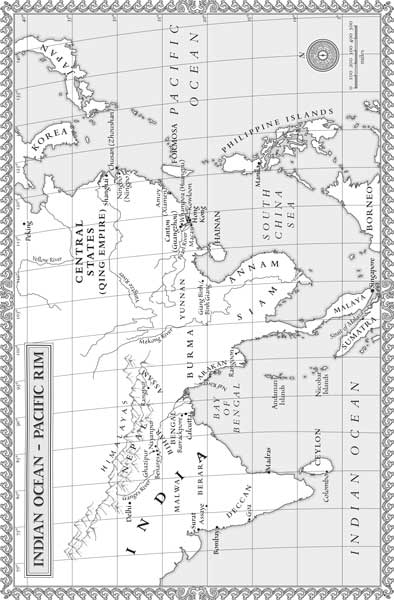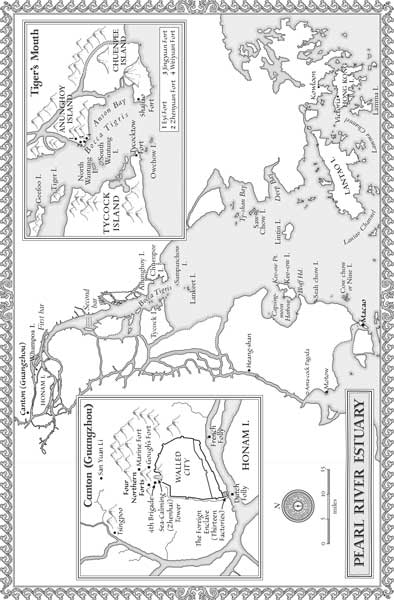Flood of Fire
Authors: Amitav Ghosh


Flood of Fire
Also by Amitav Ghosh
The Circle of Reason
The Shadow Lines
In an Antique Land
The Calcutta Chromosome
The Glass Palace
The Hungry Tide
Incendiary Circumstances
Sea of Poppies
River of Smoke
Flood of Fire
Amitav Ghosh

To Debbie
for our 25th

Maps drawn by Rodney Paull
Jacket illustration and lettering by Stephen Johnston

Maps drawn by Rodney Paull
Jacket illustration and lettering by Stephen Johnston
One

H
avildar Kesri Singh was the kind of soldier who liked to take the lead, particularly on days like this one, when his battalion was marching through a territory that had already been subdued and the advance-guard's job was only to fly the paltan's colours and put on their best parade-faces for the benefit of the crowds that had gathered by the roadside.
The villagers who lined the way were simple people and Kesri didn't need to look into their eyes to know that they were staring at him in wide-eyed wonder. East India Company sepoys were an unusual sight in this remote part of Assam: to have a full paltan of the Bengal Native Infantry's 25th Regiment â the famous âPacheesi' â marching through the rice-fields was probably as great a tamasha as most of them would witness in a year, or even a decade.
Kesri had only to look ahead to see dozens of people flocking to the roadside: farmers, old women, cowherds, children. They were racing up to watch, as if fearful of missing the show: little did they know that the spectacle would continue for hours yet.
Right behind Kesri's horse, following on foot, was the so-called Russud Guard â the âforaging party'. Behind them were the camp-followers â inaccurately named, since they actually marched ahead of the troops and far exceeded them in number, there being more than two thousand of them to a mere six hundred sepoys. Their caravan was like a moving city, a long train of ox-drawn bylees carrying people of all sorts â pandits and milk-women, shopkeepers and banjara grain-sellers, even a troupe of bazar-girls. Animals too there were aplenty â noisy flocks of sheep, goats and bullocks, and a couple of elephants as well, carrying the officers' baggage and the furniture for their mess, the tables and chairs tied on with their legs
in the air, wriggling and shaking like upended beetles. There was even a travelling temple, trundling along atop a cart.
Only after all of this had passed would a rhythmic drumbeat make itself heard and a cloud of dust appear. The ground would reverberate, in time with the beat, as the first rank of sepoys came into view, ten abreast, at the head of a long, winding river of dark topees and flashing bayonets. The sight would send the villagers scurrying for cover; they would watch from the shelter of trees and bushes while the sepoys marched by, piped along by fifers and drummers.
Few were the tamashas that could compare with the spectacle of the Bengal Native Infantry on the march. Every member of the paltan was aware of this â dandia-wallahs, naach-girls, bangy-burdars, syces, mess-consummers, berry-wallahs, bhisties â but none more so than Havildar Kesri Singh, whose face served as the battalion's figurehead when he rode at the head of the column.
It was Kesri's belief that to put on a good show was a part of soldiering and it caused him no shame to admit that it was principally because of his looks that he was so often chosen to lead the march. He could hardly be held to blame if his years of campaigning had earned him a patchwork of scars to improve his appearance â it was not as if he had asked to be grazed by a sword in such a way as to add a pout to his lower lip; nor had he invited the cut that was etched upon the leather-dark skin of his cheek, like a finely drawn tattoo.
But it wasn't as if Kesri's was the most imposing face in the paltan. He could certainly look forbidding enough when he wanted to, with his scimitar-like moustaches and heavy brow, but there were others who far surpassed him in this regard. It was in his manner of wearing the regimental uniform that he yielded to none: the heft of his thighs was such that the black fabric of his trowsers hugged them like a second skin, outlining his musculature; his chest was wide enough that the âwings' on his shoulders looked like weapons rather than ornaments; and there wasn't a man in the paltan on whom the scarlet coattee, with its bright yellow facings, showed to better advantage. As for the dark topee, tall as a beehive, he was not alone in thinking that it sat better on his head than on any other.
Kesri knew that it was a matter of some resentment among the battalion's other NCOs that he was picked to lead the column more often than any of his fellow sepoy-afsars. But their complaints caused him no undue concern: he was not a man to put much store by the opinions of his peers; they were dull stolid men for the most part, and it seemed only natural to him that they should be jealous of someone such as himself.
There was only one sepoy in the paltan whom Kesri held in high regard and he was Subedar Nirbhay Singh, the highest ranking Indian in the battalion. No matter that a subedar was outranked, on paper, by even the juniormost English subaltern â by virtue of the force of his personality, as well as his family connections, Subedar Nirbhay Singh's hold on the paltan was such that even Major Wilson, the battalion commander, hesitated to cross him.
In the eyes of the men Subedar Nirbhay Singh was not just their seniormost NCO but also their patriarch, for he was a scion of the Rajput family that had formed the paltan's core for three generations. His grandfather was the duffadar who had helped to raise the regiment when it was first formed, sixty years before: he had served as its first subedar and many of his descendants had held the post after him. The present subedar had himself inherited his rank from his older brother, who had retired a couple of years before â Subedar Bhyro Singh.
Theirs was a landowning family from the outskirts of the town of Ghazipur, near Benares. Since most of the battalion's sepoys hailed from the same area and were of the same caste, many were inevitably connected to the subedar's clan â indeed a number of them were the sons of men who had served under his father and grandfather.
Kesri was one of the few members of the paltan who lacked this advantage. The village of his birth, Nayanpur, was on the furthest periphery of the battalion's catchment area and his only connection to the subedar's family was through his youngest sister, Deeti, who was married to a nephew of his. Kesri had been instrumental in arranging this marriage, and the connection had played no small part in his rise to the rank of havildar.
Now, at the age of thirty-nine, after twenty-three years in the paltan, Kesri had a good ten or fifteen years of active service left
and he fully expected to rise soon to the rank of jamadar, with Subedar Nirbhay Singh's support. And after that, he could see no reason why he should not, in time, become the battalion's subedar himself: he did not know of a single sepoy-afsar who was his equal, in intelligence, vigour and breadth of experience. It was only his rightful due.
*
In the course of the last several months Zachary Reid had met with so many reverses that he did not allow himself to believe that his ordeal was almost over until he saw the Calcutta Gazette's report on the inquiry that had cleared his name.
5th June, 1839
⦠and this review of the week's notable events would not be complete without a mention of a recent Judicial Inquiry in which one Mr Zachary Reid, a twenty-one-year-old sailor from Baltimore, Maryland, was acquitted of all wrongdoing in the matter of the untoward incidents on the schooner
Ibis
, in the month of September last year.
Regular readers of the
Calcutta Gazette
need scarcely be reminded that the
Ibis
was bound for Mauritius, with two Convicts and a contingent of Coolies on board, when Disturbances broke out leading to the murder of the chief Sirdar of the immigrants, one Bhyro Singh, a former subedar of the Bengal Native Infantry who had numerous Commendations for bravery to his credit.
Subsequent to the murder, the Ibis was hit by a powerful Storm, at the end of which it was found that a gang of five men had also murdered the vessel's first mate, Mr John Crowle, and had thereafter effected an escape in a longboat. The ringleader was the Serang of the crew, a Mug from the Arakan, and his gang included the vessel's two convicts, one of whom was the former Raja of Raskhali, Neel Rattan Halder (the sensation that was caused in the city's Native Quarters last year, by the Raja's trial and conviction on charges of forgery, is no doubt
still fresh in the memory of most of Calcutta's European residents).
In the aftermath of the storm the stricken
Ibis
was fortunate to be intercepted by the brigantine
Amboyna
which escorted her to Port Louis without any further loss of life. On the schooner's arrival the guards who had accompanied the Coolies proceeded to lodge a complaint against Mr Reid, accusing him of conspiring in the flight of the five budmashes, one of whom, a coolie from the district of Ghazipore, was the subedar's murderer. These charges being of the utmost gravity, it was decided that the matter would be referred to the authorities in Calcutta, with Mr Reid being sent back to India in Judicial Custody.
Unfortunately for Mr Reid, he has had to endure a wait of several months after reaching Bengal, largely because of the ill-health of the principal witness, Mr Chillingworth, the captain of the
Ibis
. Mr Chillingworth's inability to travel was, we are told, the principal reason for the repeated postponements of the Inquiry â¦